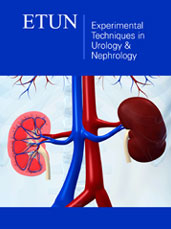- Submissions

Abstract
Experimental Techniques in Urology & Nephrology
Hyperoxaluria Induces Oxidative DNA Damage and Results in Renal Tubular Epithelial Cell Apoptosis: A Clue to the Pathogenesis of Urolithiasis
-
Open or Close Hasan Aydin1*, Faruk Yencilek2, Jale Çoban3 and Hasbey Hakan Koyuncu2
1Department of Endocrinology and Metabolism, Yeditepe University Medical Faculty, Turkey
2Department of Urology, Yeditepe University Medical Faculty, Turkey
3Department of Biochemistry, Yeditepe University Medical Faculty, Turkey
*Corresponding author: Hasan Aydin, Yeditepe Universitesi Hastanesi, İcerenkoy Mahallesi, Hastane Yolu Sokak, No: 102, Atasehir, Istanbul 34752, Turkey
Submission: September 25, 2017; Published: October 27, 2017

ISSN: 2578-0395 Volume1 Issue1
Abstract
Renal tubular injury is an essential component of renal stone disease. Several mechanisms were proposed to explain how renal tubular injury occurs. But the exact mechanism is still obscure. Oxidative damage to DNA is one of the universal mechanisms of cellular injury. Although increase in oxidative DNA damage markers was reported in urolithiasis, none of them are enough to prove the direct effect of calcium oxalate crystals. The aim of this study was to investigate whether oxidative DNA damage and renal tubular cell apoptosis markers can be induced by hyperoxaluria in an animal model. A total of 16 Sprague Dowley rats have been included into study. Group I (n=8): Hyperoxaluria-induced group; Group II (n=8): Control group. Twenty four hour urine samples were collected at 24 hour, 14 day and 28 day after hyperoxaluric diet for the analysis of 8-hydroxydeoxyguanosine (8- OHG) and oxalate excretion. Rats were euthanized at 28th day and right kidney was taken for immunohistochemical analysis for apoptosis markers Fas, TNF-α. Compared to controls, 8-OHdG excretion was found to be higher in hyperoxaluric group (p<.05). It began to rise early at 24-hour samples and maintained the level throughout 28-day period. It was positively correlated with urinary oxalate excretion (p=.03, r=.53) and renal tubular epithelial cell apoptosis markers (p=.007, r=.710). Results indicate hyperoxaluria induced oxidative damage to DNA mediates renal tubular injury. This may contribute to the pathophysiology of renal stone disease and help to explain its relationship with other systemic diseases.
Keywords: Hyperoxaluria; Apoptosis; 8-hydroxydeoxyguanosine; Oxidative DNA damage; Urolithiasis
 a Creative Commons Attribution 4.0 International License. Based on a work at www.crimsonpublishers.com.
Best viewed in
a Creative Commons Attribution 4.0 International License. Based on a work at www.crimsonpublishers.com.
Best viewed in 







.jpg)






























 Editorial Board Registrations
Editorial Board Registrations Submit your Article
Submit your Article Refer a Friend
Refer a Friend Advertise With Us
Advertise With Us
.jpg)






.jpg)














.bmp)
.jpg)
.png)
.jpg)










.jpg)






.png)

.png)



.png)






